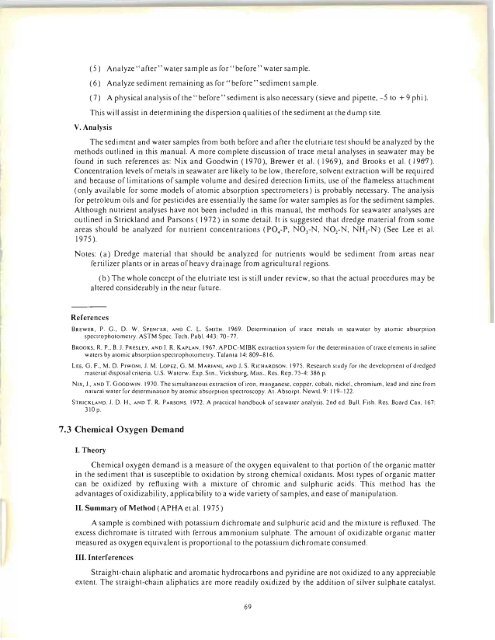You also want an ePaper? Increase the reach of your titles
YUMPU automatically turns print PDFs into web optimized ePapers that Google loves.
(5) Analyze" after" water sample as for" before" water sam pie.<br />
(6) Analyze sediment remaining as for" before" sediment sample.<br />
(7) A physical analysis of the "before" sediment is also necessary (sieve and pipette, -5 to + 9 phi).<br />
This will assist in determining the dispersion qualities of the sediment at the dump site.<br />
V. Analysis<br />
The sediment and water <strong>samples</strong> from both before and after the elutriate test should be analyzed by the<br />
methods outlined in this manual. A more complete discussion of trace metal analyses in seawater may be<br />
found in such references as: Nix and Goodwin ( 1970), Brewer et al. ( 1969), and Brooks et al. ( 196'7).<br />
Concentration levels of metals in seawater are likely to be low, therefore, solvent extraction will be required<br />
and because of limitations of sample volume and desired detection limits, use of the f1ameless attachment<br />
(only available for some models of atomic absorption spectrometers) is probably necessary. The analysis<br />
for petroleum oils and for pesticides are essentially the same for water <strong>samples</strong> as for the sediment <strong>samples</strong>.<br />
Although nutrient analyses have not been included in this manual, the methods for seawater analyses are<br />
outlined in Strickland and Parsons ( 1972) in some detail. It is suggested that dredge material from some<br />
areas should be analyzed for nutrient concentrations (P0 4 -P, NOJ-N, N0 2 -N, NHJ-N) (See Lee et al.<br />
1975 ).<br />
Notes: (a) Dredge material that should be analyzed for nutrients would be sediment from areas near<br />
fertilizer plants or in areas of heavy drainage from agricultural regions.<br />
(b) The whole concept of the elutriate test is still under review, so that the actual procedures may be<br />
altered considerably in the near future.<br />
References<br />
BREWER, P. G., D. W. SPENC'ER, AND C. L. SMITH . 1969. Determination of trace metals in seawater by atomic absorption<br />
spectrophotometry. ASTM Spec. Tech. Publ. 443: 70-77.<br />
BROOKS, R. P., B. J. PRESLEY, AND I. R. KAPLAN. 1967. APDC-MIBK extraction system for the determination of trace elements in saline<br />
waters by atomic absorption spectrophotome try. Talanta 14: 809- 816.<br />
LEE, G. F., M. D. PtWONI, J. M. LOPEZ, G. M. MARIANt, AND J. S. RI CHARDSON. 1975. Research study for the development of dredged<br />
material disposal criteria. U.S. Waterw. Exp. Stn., Vicksburg, Miss., Res. Rep. 75-4: 386 p.<br />
NIX, J., AND T. GOODWtN . 1970. The simultaneous extraction of iron, manganese, copper. cobalt, nickel, chromium, lead and zinc from<br />
natural water for determination by atomic absorption spectroscopy. At. Absorpt. News!. 9: 119-122.<br />
STRICKLAND. J. D. H., AND T. R. PARSONS. 1972. A practical handbook of seawater analysis. 2nd ed. Bull. Fish. Res. Board Can. 167:<br />
310 p.<br />
7.3 Chemical Oxygen Demand<br />
I. Theory<br />
Chemical oxygen demand is a measure of the oxygen equivalent to that portion of the organic matter<br />
in the sediment that is susceptible to oxidation by strong chemical oxidants. Most types of organic matter<br />
can be oxidized by refluxing with a mixture of chromic and sulphuric acids. This method has the<br />
advantages of oxidizability, applicability to a wide variety of sam pies, and ease of manipulation.<br />
II. Summary of Method (APHA et al. 1975)<br />
A sample is combined with potassium dichromate and sulphuric acid and the mixture is refluxed. The<br />
excess dichromate is titrated with ferrous ammonium sulphate. The amount of oxidizable organic matter<br />
measured as oxygen equivalent is proportional to the potassium dichromate consumed.<br />
III. Interferences<br />
Straight-chain aliphatic and aromatic hydrocarbons and pyridine are not oxidized to any appreciable<br />
extent. The straight-chain aliphatics are more readily oxidized by the addition of silver sulphate catalyst.<br />
69

















